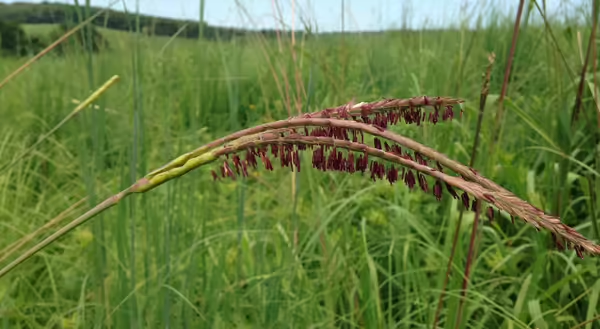
When I hike in the woods during the spring, I’m always excited to see my favorite spring ephemerals in bloom. I can recognize Celandine Poppy by the sunshine yellow flowers with four petals, Yellow Trout Lily by the recurved, yellow petals forming an upside-down cup, and Pawpaw by the maroon colored flowers seen when looking up in the forest.
What do all these plants have in common? Their main distinguishing identification feature is their flower. What do we do when we try to identify a grass? Do grasses have flowers, and how can we use them in identification?

Do grasses flower?
Yes, grasses flower – but their flowers are a reduced form of the showy flowers with petals that we are accustomed to seeing. Why is that? Grasses are wind-pollinated, so they do not need to put energy into developing a showy flower to attract pollinators.
The flowering unit of a grass is called a spikelet. Spikelets can contain many parts and pieces, such as glumes, florets, paleas, and lemmas – for basic grass identification, we aren’t going to get too much into the nitty gritty. We will focus our attention on the spikelet as a whole, its general size and shape, and how it is arranged on the grass.
Grass spikelets, just like flowers, are held in arrangements called inflorescences. Here the stem becomes the rachis, which is the main axis of the inflorescence. The rachis can be branched or unbranched.

Three main inflorescence types
In grasses, there are three main types of inflorescences: spikes, panicles, and racemes. There are a few easy characteristics you can use to tell the difference between these three - you'll look to see if the rachis (the stem of an inflorescence) branches, and if the spikelets are held on pedicels (little stalks).
Spikes are collections of spikelets that are directly attached to the rachis. This means there are no branches and no pedicels. That’s pretty easy! Examples of grasses with spike inflorescences include the ryes, barleys, and timothy.
Panicles have branches, and their spikelets can either be held on pedicels or be directly attached to the branch. The big difference here is that the rachis of a panicle branches. Panicles can come in different shapes and sizes, but always have branches. Look at Indiangrass, switchgrass, river oats, and Johnsongrass to find panicle inflorescences.
Last is the raceme. I use this is the catch-all category. If an inflorescence does not branch, but spikelets, or a dense collection of spikelets, are held on a pedicel, then it is a raceme. Sometimes it can be difficult to tell the difference between a branch and a pedicel, but with practice it becomes easier. If you are familiar with the finger-like clusters of spikelets on crabgrass, that's one example of dense clusters of spikelets held on a pedicel that we'd find in a raceme. Look at little bluestem and broomsedge as well as big bluestem, gama grass, and side oats grama for examples of racemes.

Characteristics of spikelets
Besides looking at the arrangement of the inflorescence, what other characteristics can you look for in a spikelet? You can look for the presence of awns and bristles. Awns look like a bristle, but they extend from the tip of a spikelet. Awns can come in different sizes and arrangements: some grasses have 2-3 awns emerging from a single spikelet, and they can be very long or quite short. Bristles, in contrast, are found at the base of a spikelet, and often surround the spikelet like a bowl. They are most commonly found in foxtails.
If you catch a grass in bloom, you may see the male and female reproductive structures. The female stigma will look like feathery moth antennae, while the male anthers will be exserted and often bright in color (yellow, red, or orange).
Now when identifying a grass, start with the spikelets! What arrangement of spikelets do you see? What do the spikelets look like, and do they have awns or bristles?
Never miss a new post! Sign up for our email list.
ABOUT THE AUTHOR: Erin Garrett is a Natural Resources, Environment, and Energy Educator for University of Illinois Extension serving Alexander, Johnson, Massac, Pulaski, and Union counties. Erin develops and delivers high impact programming to adults and youth to help them develop an appreciation for natural resources and to empower them to make small changes to positively impact the environment. Erin’s programming focuses on why homeowners should consider choosing native plants, how to support native pollinators, how to identify grasses, how to identify and manage invasive species, and developing an appreciation for prairie ecosystems.
ABOUT THE BLOG: Grasses at a Glance dives into grass identification, focusing on tips and tricks that make grass identification possible. Get information about native and non-native species, how to tell look-alikes apart, and which grasses you can find in Illinois.